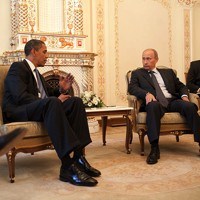I had the opportunity to spend part of last week in Russia, giving a talk at the Moscow Carnegie Center on U.S.-Russia security cooperation after Ukraine, and attending the third annual Moscow International Security Conference, organized by the Russian Defense Ministry. The difference between the two audiences was striking: The talk at Carnegie attracted mostly members of the liberal intelligentsia eager to manage the Ukraine crisis in a way that preserves U.S.-Russian cooperation in some areas; in contrast, the Russians who addressed the conference, including top officials of the Russian Foreign and Defense Ministries as well as the armed services, took a very hard line against Western policies in Europe, the Middle East and Asia. In the end, only a few opportunities for near-term U.S.-Russian security cooperation were identified, most notably regarding Afghanistan and Iran’s nuclear program.
Whereas in its first two years the Moscow security conference focused on NATO’s missile defense system and then European security, with missile defenses still prominent on the agenda, the official focus of this year’s conference was on resolving regional conflicts in the Middle East, North Africa and South Asia. Of course, events in Ukraine still drew much attention; the Ukrainian presidential election occurred a day after the conference ended. Russian conference speakers accused Western governments of forcing Ukraine and other former Soviet republics to choose between Moscow and the West, of militarizing the crisis through a NATO defense buildup and of siding with neo-Nazi groups waging a reign of terror against the ethnic Russians in Ukraine.
Unlike the first two conferences, U.S. and NATO officials refused to attend this year’s session due to the official suspension of joint military activities following the Russian annexation of Crimea. A U.S. official also told me last month that the boycott was also intended to avoid legitimizing an event designed to publicize Russian views on international security at a time when the Russian military was seizing, or threatening to seize, other countries’ territories. The conference’s four U.S.-based attendees were all affiliated with various think tanks, while the other 300-odd attendees included Russia’s highest national security officials as well as senior defense officials from the other former Soviet republics and the Middle East. Almost all the media also came from these regions.

